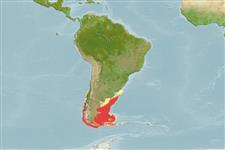| Native range | All suitable habitat | Point map | Year 2050 |

|
| This map was computer-generated and has not yet been reviewed. |
| Macruronus magellanicus AquaMaps Data sources: GBIF OBIS |
Issue
This species is synonym of Macruronus novaezelandiae (Hector, 1871) in Eschmeyer (CofF ver. Jan. 2012: Ref. 89336). Waiting for more confirmation. Please send references or more studies are needed.